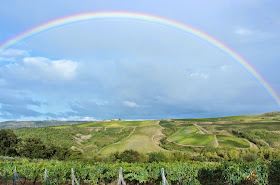If you have ever been to Italy you will
understand how many wineries there are and places to taste wine and
olive oil. It can be overwhelming which one to stop in at. I've
always been one to stop in at the names that I don't recognize from
the states. These are the vineyards that you can't easily access and
where you will sometimes be surprised by the quality of the producer,
but they may not export large amounts due to their production or it
may be hard to find in your market. It is also pretty neat though to
stop in at the well known wineries as well and to see the operations
and meet the folks that work hard to produce the wines that we
fortunately get to enjoy.
I was invited by Robert Dwyer of the Wellesley Wine Press to write this blog as he will be visiting this region soon and will even be staying at the place where I got married in Bucine, Iesolana. Today I'm going to cover 5 of the
wineries that I have visited that I would recommend stopping in and
tasting the wines in the region of Tuscany. For my full details on each follow along on the Wellesley Wine Press.
Montalcino
Fattoria dei Barbi
I visited the Fattoria dei Barbi estate in 2007 in the town of Montalcino. The Colombini family that owns and manages the estate started making the famous Brunello with Biondi Santi in the 1780's.
I visited the Fattoria dei Barbi estate in 2007 in the town of Montalcino. The Colombini family that owns and manages the estate started making the famous Brunello with Biondi Santi in the 1780's.
Poggio Antico started off in the late 1970's. I visited them back in 2004 before I developed my strong sense of love for italian wines, but you know quality when you taste it.
Montepulciano
Poliziano
I visited Poliziano in 2007 in the town of Montepulciano not too far from Montalcino, about 30-40 minutes. Lots of drinking going on for my 2007 trip for sure. How can you not?
I visited Poliziano in 2007 in the town of Montepulciano not too far from Montalcino, about 30-40 minutes. Lots of drinking going on for my 2007 trip for sure. How can you not?
Chianti region
Vignavecchia
On my recent visit last October I stopped in at Vignavecchia in Radda. The workers were outside eating lunch when I arrived.
On my recent visit last October I stopped in at Vignavecchia in Radda. The workers were outside eating lunch when I arrived.
Castellare di Castellina
Another winery I visited this past October in the Chianti Classico region, that is more well known, was Castellare di Castellina in the town of Castellina. This winery has received a number of awards for their wines.
Another winery I visited this past October in the Chianti Classico region, that is more well known, was Castellare di Castellina in the town of Castellina. This winery has received a number of awards for their wines.
 |
| Castellare di Castellina |
Of course there are many more wineries
I could discuss, but I tried to mention some of the ones where I had
an enjoyable experience. When I open some of my bottles that I still
have from this list I will absolutely share them with you on my blog. Have you visited any of these wineries or others that you personally enjoyed?























